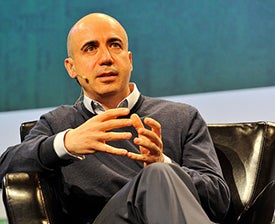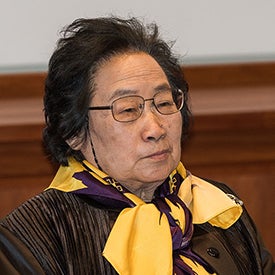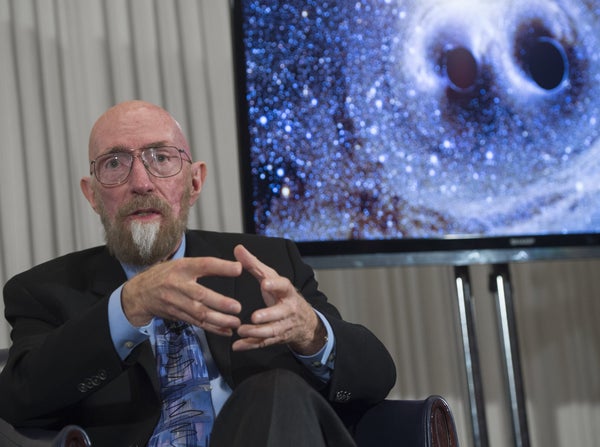HED: Science Moves and Shakes Time’s Top 100 List
DEK: Scientists, engineers and tech developers earn spots on magazine’s list of the year’s most influential people
Byline: Jennifer Hackett
On supporting science journalism
If you're enjoying this article, consider supporting our award-winning journalism by subscribing. By purchasing a subscription you are helping to ensure the future of impactful stories about the discoveries and ideas shaping our world today.
This year 14 scientists, engineers and technology developers earned spots on Time magazine’s Top 100 Most Influential People. The categories include pioneers, leaders, icons, titans and artists, and most of this year’s names were in the pioneer category. Scientific American looks back on its coverage of these groundbreaking individuals.
Kip Thorne (Gravitational waves, black holes, Interstellar)
The Laser Interferometer Gravitational-Wave Observatory or LIGO detected gravitational waves and confirmed a century-old prediction by Albert Einstein this year, 32 years after its founding. Astrophysicist Kip Thorne was the leading founder of LIGO and thus played a vital role in this major physics breakthrough. Thorne also consulted on the sci-fi hit film Interstellar, working closely with director Christopher Nolan to help craft a science-driven story.
Kathy Niakan (CRISPR, genomics)
Kathy Niakan made headlines when she received U.K. authorities’ permission to use CRISPR, a genomic editing system, on human embryos. Niakan is using CRISPR to study the effects of genes on human development in order to better understand embryonic health, infertility and pregnancy. The edited embryos will never be implanted in a womb, but in order to work with them, Niakan had to navigate a delicate and controversial field.
Marc Edwards and Mona Hanna-Attisha (Flint water crisis)
Although residents knew there was something wrong with their water supply in Flint, Mich., it took two scientific whistleblowers to get the lead poisoning crisis taken seriously. Virginia Tech civil engineering professor Marc Edwards, an expert on water corrosion, conducted a study that uncovered high levels of lead in Flint’s drinking water, while pediatrician Mona Hanna-Attisha tested the children of Flint, proving they had significant lead poisoning.
Alan Stern (New Horizons)
Engineer and planetary scientist Alan Stern first tried to get a space probe to Pluto more than three decades ago. Stern’s passion and dedication as principal investigator helped New Horizons reach Pluto in 2015, and it sent back wave after wave of high-resolution images and data. New Horizons’ findings have fundamentally changed how we think about the dwarf planet, and the probe will go on to explore the Kuiper Belt to further understanding of the solar system.
Lee Berger (Homo naledi) Homo naledi, a newly identified species of protohuman, has been making headlines since its discovery by paleoanthropologist Lee Berger, whose team recovered more than 1,500 fossil specimens representing at least 15 individuals from a cave in South Africa. The remains were found in a deep chamber, possibly indicating that Homo naledideliberately disposed of its dead—a trait thought to be unique to Homo sapiens. The find is controversial, but decidedly fascinating.
Hope Jahren (women in science)
It has been a tumultuous year for women in science, with sexual harassment scandals erupting at multiple institutions. Hope Jahren, a tenured professor at the University of Hawaii at Manoa who researches fossilized plant life, refuses to keep quiet about the widespread issue of harassment and discrimination in science. By calling out science’s sexism problems, Jahren hopes to address the toxic culture that’s causing women to leave the field.
Dan Carder (VW emissions scandal)
The Volkswagen emissions scandal revealed that although VW vehicles passed Environmental Protection Agency regulations, they were actually emitting 35 times the maximum permitted levels of nitrogen oxides. The cars used software that could cheat on emissions tests by artificially lowering emissions during testing conditions. Dan Carder, an engineer at West Virginia University, tested the vehicles at the request of the International Council on Clean Transportation and brought the corporation’s fraud to light.
Sunita Narain (air pollution in India)
Sunita Narain’s organization, the Centre for Science and Environment, has been fighting air pollution in India for just shy of two decades. Narain, an environmentalist and activist, has pressured the Indian government to embrace pollution-alleviating recommendations and has advocated for India’s forest-dwellers and indigenous peoples who are often falsely blamed for environmental problems.
Palmer Luckey (virtual reality)
Virtual reality has been heralded as the next step in entertainment for decades. And now Palmer Luckey, the 23-year-old founder of Oculus VR and the inventor of the Oculus Rift, is making that next step happen. Whether used for video games or as emotive tie-ins to films such as The Martian, or for recording real-world tragedies including the Syrian refugee crisis, the virtual reality technology pioneered by Luckey is being put to use all over.
Priscilla Chan and Mark Zuckerberg (Facebook)
The husband-and-wife team behind Facebook is putting its wealth to use in the form of the Chan Zuckerberg Initiative. They announced that they are committing 99 percent of their wealth to tackling social inequality via measures aimed at improving education, funding disease research and empowering communities.
Sindar Pichai (Google)
The new CEO of Google, engineer Sindar Pichai, has been involved in developing many of the company’s most-used products including Google Drive, Maps, Chrome and Gmail. He also oversees Android.

Yuri Milner.
TechCrunch/Flickr, CC BY 2.0
Yuri Milner (Breakthrough Starshot)
Russian entrepreneur and physicist Yuri Milner does not shy away from big ideas. Along with theoretical physicist Stephen Hawking, Milner heads Breakthrough Starshot—a $100 million plan to use lasers to propel minuscule spacecraft to Alpha Centauri. Milner is no stranger to funding space-related projects: He also committed at least $100 million to support SETI in the form of Breakthrough Listen, hunting for extraterrestrial life. His Breakthrough Prize has supported neutrino experiments and abstract mathematics.
Tim Cook (Apple)
When Steve Jobs died, Apple’s next CEO had an intimidating role to fill. Tim Cook stepped up and garnered much admiration for his leadership of the company. He recently was in the news for refusing to comply with the FBI’s request to help unlock the San Bernardino shooter’s iPhone out of concern for the digital security of millions of Apple customers.

Youyou Tu .
Credit: Bengt Nyman/Wikimedia Commons, CC BY-SA 4.0
Youyou Tu (Nobel Prize for discovery of artemisinin) When
studying traditional Chinese medicines, pharmaceutical chemist Youyou Tu discovered a new drug for treating malaria. She extracted artemisinin by soaking—not boiling—sweet wormwood, following an ancient recipe. Artemisinin is now a main line of defense against malaria and earned Tu a Nobel Prize, making her the first woman in China to win one.
